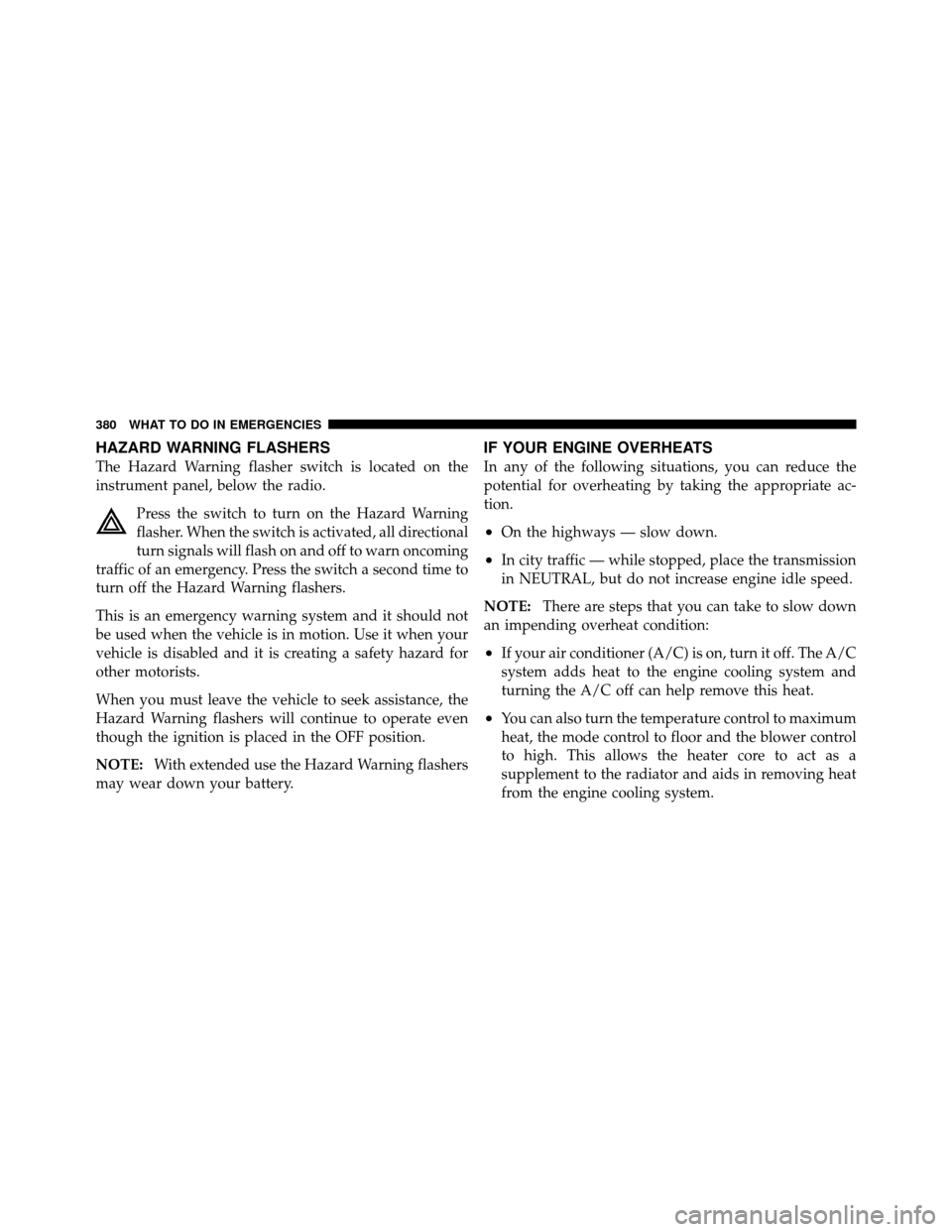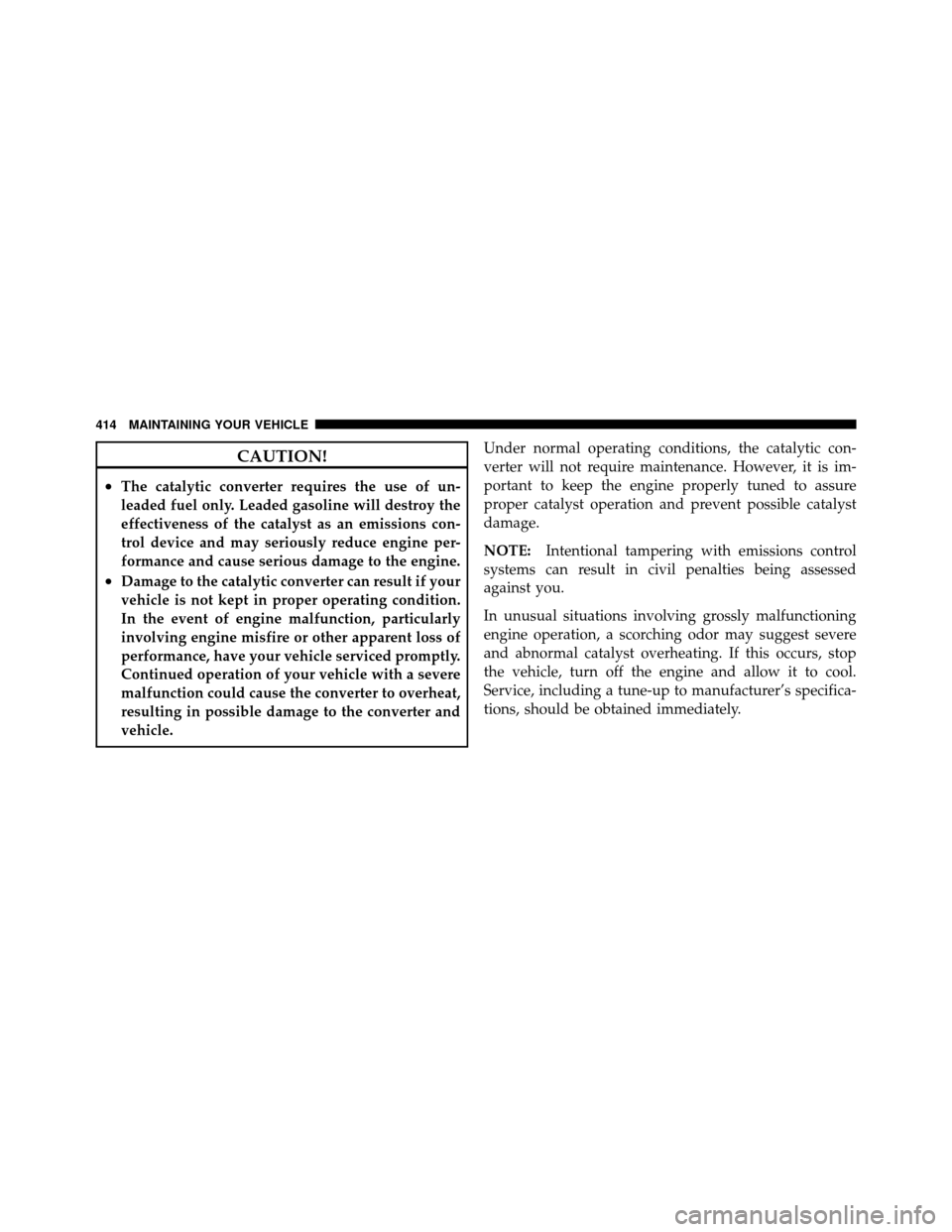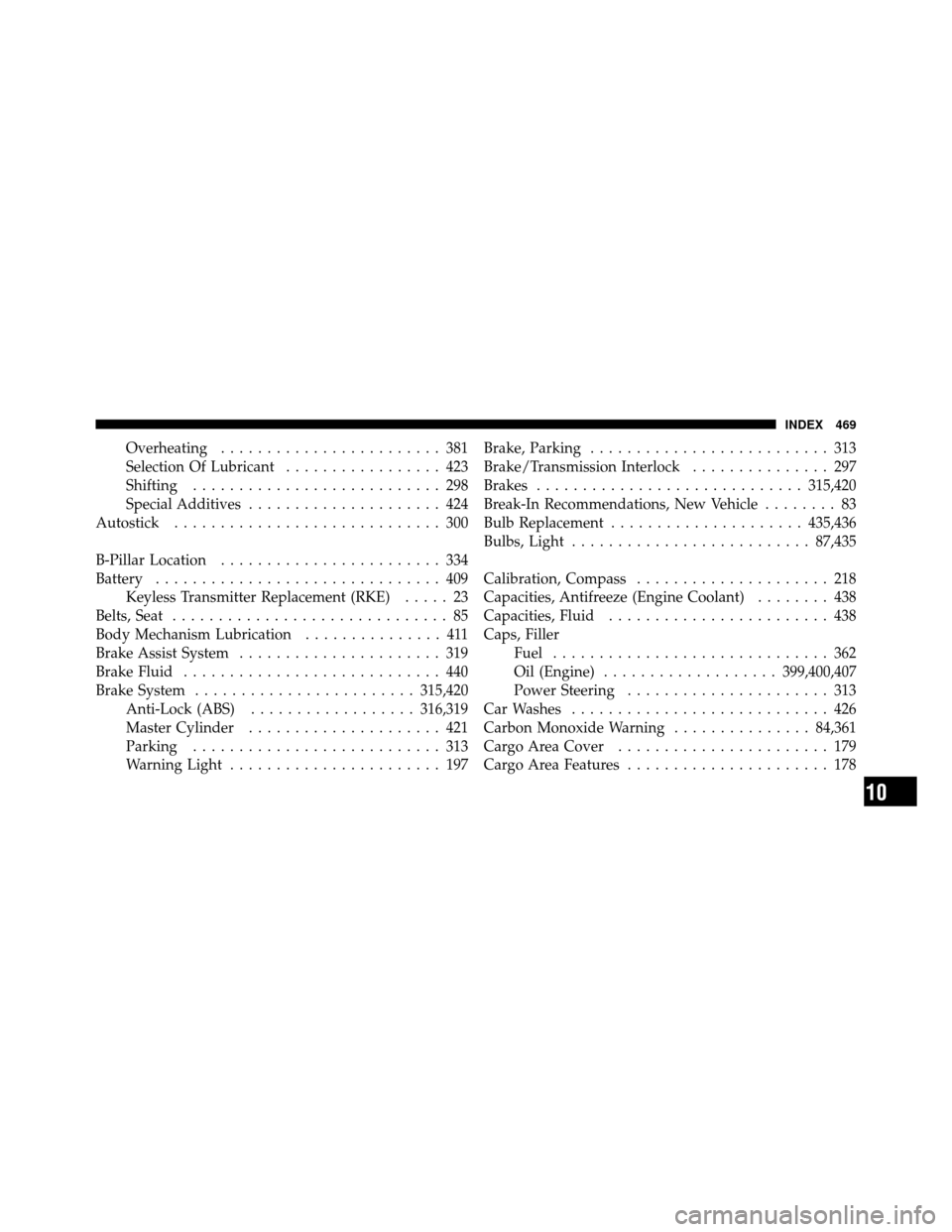2011 JEEP PATRIOT engine overheat
[x] Cancel search: engine overheatPage 382 of 490

HAZARD WARNING FLASHERS
The Hazard Warning flasher switch is located on the
instrument panel, below the radio.Press the switch to turn on the Hazard Warning
flasher. When the switch is activated, all directional
turn signals will flash on and off to warn oncoming
traffic of an emergency. Press the switch a second time to
turn off the Hazard Warning flashers.
This is an emergency warning system and it should not
be used when the vehicle is in motion. Use it when your
vehicle is disabled and it is creating a safety hazard for
other motorists.
When you must leave the vehicle to seek assistance, the
Hazard Warning flashers will continue to operate even
though the ignition is placed in the OFF position.
NOTE: With extended use the Hazard Warning flashers
may wear down your battery.
IF YOUR ENGINE OVERHEATS
In any of the following situations, you can reduce the
potential for overheating by taking the appropriate ac-
tion.
•On the highways — slow down.
•In city traffic — while stopped, place the transmission
in NEUTRAL, but do not increase engine idle speed.
NOTE: There are steps that you can take to slow down
an impending overheat condition:
•If your air conditioner (A/C) is on, turn it off. The A/C
system adds heat to the engine cooling system and
turning the A/C off can help remove this heat.
•You can also turn the temperature control to maximum
heat, the mode control to floor and the blower control
to high. This allows the heater core to act as a
supplement to the radiator and aids in removing heat
from the engine cooling system.
380 WHAT TO DO IN EMERGENCIES
Page 383 of 490

CAUTION!
Driving with a hot cooling system could damage
your vehicle. If the pointer rises to the H (red) mark,
the instrument cluster will sound a chime. When
safe, pull over and stop the vehicle with the engine at
idle. Turn off the air conditioning and wait until the
pointer drops back into the normal range. If the
pointer remains on the H (red) mark for more than a
minute, turn the engine off immediately and call for
service.
WARNING!
You or others can be badly burned by hot engine
coolant (antifreeze) or steam from your radiator. If
you see or hear steam coming from under the hood,
do not open the hood until the radiator has had time
to cool. Never try to open a cooling system pressure
cap when the radiator or coolant bottle is hot.
AUTOMATIC TRANSMISSION OVERHEATING
During sustained high speed driving or trailer towing up
long grades on hot days, the automatic transmission oil
may become too hot.If this happens, the transmission overheat in-
dicator light will come on, and the vehicle will
slow slightly until the automatic transmission
cools down enough to allow a return to the
requested speed. If the high speed is maintained, the
overheating may reoccur, as before, in a cyclic fashion.6
WHAT TO DO IN EMERGENCIES 381
Page 395 of 490

FREEING A STUCK VEHICLE
If your vehicle becomes stuck in mud, sand or snow, it
can often be moved by a rocking motion. Turn your
steering wheel right and left to clear the area around the
front wheels. Then shift back and forth between DRIVE/
1st gear and REVERSE. Using minimal accelerator pedal
pressure to maintain the rocking motion, without spin-
ning the wheels, is most effective.
CAUTION!
Racing the engine or spinning the wheels may lead to
transmission overheating and failure. Allow the en-
gine to idle with the shift lever in NEUTRAL for at
least one minute after every five rocking-motion
cycles. This will minimize overheating and reduce
the risk of transmission failure during prolonged
efforts to free a stuck vehicle.NOTE:
If your vehicle is equipped with Traction Con-
trol or Electronic Stability Control (ESC), turn the system
OFF before attempting to “rock” the vehicle.
CAUTION!
•When “rocking” a stuck vehicle by moving be-
tween DRIVE/1st gear and REVERSE, do not spin
the wheels faster than 15 mph (24 km/h), or drive-
train damage may result.
•Revving the engine or spinning the wheels too fast
may lead to transmission overheating and failure.
It can also damage the tires. Do not spin the
wheels above 30 mph (48 km/h) while in gear (no
transmission shifting occurring).
6
WHAT TO DO IN EMERGENCIES 393
Page 416 of 490

CAUTION!
•The catalytic converter requires the use of un-
leaded fuel only. Leaded gasoline will destroy the
effectiveness of the catalyst as an emissions con-
trol device and may seriously reduce engine per-
formance and cause serious damage to the engine.
•Damage to the catalytic converter can result if your
vehicle is not kept in proper operating condition.
In the event of engine malfunction, particularly
involving engine misfire or other apparent loss of
performance, have your vehicle serviced promptly.
Continued operation of your vehicle with a severe
malfunction could cause the converter to overheat,
resulting in possible damage to the converter and
vehicle.Under normal operating conditions, the catalytic con-
verter will not require maintenance. However, it is im-
portant to keep the engine properly tuned to assure
proper catalyst operation and prevent possible catalyst
damage.
NOTE:
Intentional tampering with emissions control
systems can result in civil penalties being assessed
against you.
In unusual situations involving grossly malfunctioning
engine operation, a scorching odor may suggest severe
and abnormal catalyst overheating. If this occurs, stop
the vehicle, turn off the engine and allow it to cool.
Service, including a tune-up to manufacturer’s specifica-
tions, should be obtained immediately.
414 MAINTAINING YOUR VEHICLE
Page 420 of 490

Use only high purity water such as distilled or deionized
water when mixing the water/engine coolant (antifreeze)
solution. The use of lower quality water will reduce the
amount of corrosion protection in the engine cooling
system.
Please note that it is the owner’s responsibility to main-
tain the proper level of protection against freezing ac-
cording to the temperatures occurring in the area where
the vehicle is operated.
NOTE:Mixing engine coolant (antifreeze) types will
decrease the life of the engine coolant (antifreeze) and
will require more frequent coolant changes.
Cooling System Pressure Cap
The cap must be fully tightened to prevent loss of engine
coolant (antifreeze) and to ensure that engine coolant
(antifreeze) will return to the radiator from the coolant
recovery bottle. The cap should be inspected and cleaned if there is any
accumulation of foreign material on the sealing surfaces.
WARNING!
•The warning words “DO NOT OPEN HOT” on
the cooling system pressure cap are a safety pre-
caution. Never add engine coolant (antifreeze)
when the engine is overheated. Do not loosen or
remove the cap to cool an overheated engine. Heat
causes pressure to build up in the cooling system.
To prevent scalding or injury, do not remove the
pressure cap while the system is hot or under
pressure.
•Do not use a pressure cap other than the one
specified for your vehicle. Personal injury or en-
gine damage may result.
418 MAINTAINING YOUR VEHICLE
Page 471 of 490

Overheating........................ 381
Selection Of Lubricant ................. 423
Shifting ........................... 298
Special Additives ..................... 424
Autostick ............................. 300
B-Pillar Location ........................ 334
Battery ............................... 409
Keyless Transmitter Replacement (RKE) ..... 23
Belts, Seat .............................. 85
Body Mechanism Lubrication ............... 411
Brake Assist System ...................... 319
Brake Fluid ............................ 440
Brake System ........................ 315,420
Anti-Lock (ABS) .................. 316,319
Master Cylinder ..................... 421
Parking ........................... 313
Warning Light ....................... 197 Brake, Parking
.......................... 313
Brake/Transmission Interlock ............... 297
Brakes ............................. 315,420
Break-In Recommendations, New Vehicle ........ 83
Bulb Replacement ..................... 435,436
Bulbs, Light .......................... 87,435
Calibration, Compass ..................... 218
Capacities, Antifreeze (Engine Coolant) ........ 438
Capacities, Fluid ........................ 438
Caps, Filler Fuel .............................. 362
Oil (Engine) ................... 399,400,407
Power Steering ...................... 313
Car Washes ............................ 426
Carbon Monoxide Warning ...............84,361
Cargo Area Cover ....................... 179
Cargo Area Features ...................... 178
10
INDEX 469
Page 474 of 490

Electronic Brake Control System............. 319
Anti-Lock Brake System ................ 319
Brake Assist System ................... 319
Electronic Roll Mitigation ............... 321
Traction Control System ................ 320
Electronic Speed Control (Cruise Control) ...... 157
Electronic Stability Control (ESC) ............. 325
Electronic Vehicle Information Center (EVIC) .... 209
Emergency, In Case of Jacking ............................ 382
Jump Starting ....................... 388
Towing ............................ 395
Emission Control System Maintenance ......... 402
Engine ............................ 399,400
Block Heater ........................ 293
Break-In Recommendations .............. 83
Checking Oil Level ................... 405
Cooling ........................... 415 Exhaust Gas Caution
................84,361
Fuel Requirements .................... 358
Jump Starting ....................... 388
Oil ......................... 405,438,439
Oil Change Interval ................... 406
Oil Filler Cap .................. 399,400,407
Oil Filter ........................... 439
Oil Selection ........................ 406
Oil Synthetic ........................ 407
Overheating ........................ 380
Temperature Gauge ................... 200
Enhanced Accident Response Feature .......... 70
Ethanol ............................... 359
Event Data Recorder ...................... 73
Exhaust Gas Caution ................. 36,84,361
Exhaust System ....................... 84,413
Exterior Lights .......................... 87
472 INDEX
Page 480 of 490

Modifications/Alterations, Vehicle............. 8
Monitor, Tire Pressure System ............... 349
Mopar Parts ......................... 403,462
MTBE/ETBE ........................... 359
Multi-Function Control Lever ............... 148
New Vehicle Break-In Period ................ 83
Occupant Restraints ................... 37,66,70
Occupant Restraints (Sedan) ...........63,64,66,69
Octane Rating, Gasoline (Fuel) .............. 358
Odometer ............................. 203
Trip ........................... 201,203
Oil Change Indicator ..................... 212
Oil Change Indicator, Reset ................. 212
Oil, Engine ......................... 405,438
Capacity ........................... 438
Change Interval ..................... 406
Checking .......................... 405 Disposal
........................... 407
Filter ............................. 408
Identification Logo ................... 406
Materials Added to ................... 407
Recommendation .................. 406,438
Synthetic .......................... 407
Viscosity ........................... 407
Onboard Diagnostic System ..............401,402
Opener, Garage Door (HomeLink®) ........... 160
Operator Manual (Owner’s Manual) ............ 5
Overdrive ............................. 300
Overheating, Engine ................... 200,380
Owner’s Manual (Operator Manual) .........5,463
Paint Care ............................. 426
Panic Alarm ............................ 22
Parking Brake .......................... 313
Passing Light ........................... 150
Personal Settings ........................ 214
478 INDEX